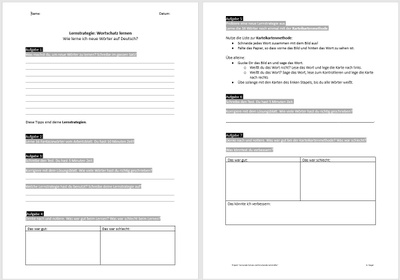"Welcome Class" 2: Learning Strategies
Description of the teaching development project "Learning Strategies"
Title: “Promoting independent learning through strategy training”
Development goals
- Joint familiarization with existing and new strategies for vocabulary learning in the beginner and advanced groups of the welcome classes
- Promoting pupils' self-efficacy in learning German, also in preparation for independent language learning in the regular classroom
Teaching measures
The 1st intervention was carried out in the group of advanced pupils. After a general oral brainstorming session on learning strategies, the teacher focused on vocabulary learning: “What do you do to learn vocabulary?” He noted the answers on the board. He then added some strategies and introduced a new method, which the pupils then tried out. This was the “index card method”, in which the picture and word are noted on both sides of a card and then used for receptive or productive vocabulary learning; the cards were sorted according to “known” and “not known” - two piles were always created for revision.
Afterwards, the pupils were given a sheet with fantasy words (to exclude prior knowledge for the test) and pictures to try out which they could memorize using this method (or another method). After 10 minutes, the children looked at which of these words they could memorize: they compared them with the words on the first sheet. Using this experience, the pupils then reflected in the group on the effectiveness of the method(s) tried out. The teacher asked: “What worked well, what didn't work so well? What did you think of the 'index card method' for practicing?” Overall, a large part of the lesson was conducted orally in plenary and with little written support, which is why the teacher created a structuring worksheet for the second implementation in the other class a week later.
Fantasy word list (Photo: C. Saunders)
In the second intervention - in the beginners' group - the method was adapted: the worksheet supported communication and task completion. Initially, the teacher wrote down the strategies mentioned by the pupils on pieces of paper and placed them on the table where they were sitting. The children then worked with the worksheets, in dialog with the teacher and with each other. Afterwards, there was again the fantasy word test and a reflection, this time also with the help of the worksheet.
Arbeitsmaterial: Arbeitsblatt zur Erarbeitung der Strategien
Accompanying research/ evaluation
The tests were used to assess the effectiveness of the interventions - in conjunction with the pupils' feedback, they showed how helpful the introduction of the learning strategy(ies) was for vocabulary learning. The plenary discussion following the trial provided insights into the children's experiences and self-awareness. In addition, the teacher and the researcher were able to observe how the children worked on these tasks individually by observing them during the two lessons (e.g. during the independent work phase and the test): “This gave me an impression of how they memorize words that were previously a ‘black box’ for me,” the teacher wrote afterwards.
Results
The children generally found the new topic exciting, but some found it difficult to describe their own learning activities in German, especially in the beginners' group. For some, it seemed to be a new experience to deal with their own learning strategies. Making the cards was fun for most and they made an effort to memorize the words - some wrote the German translation next to the fantasy words on the vocabulary sheet, and some also recognized something about their own learning. The results of the tests were very different; possible influencing factors could be the diversity of learning experiences in the welcome class, the unfamiliar approach, the different acceptance of the contextless fantasy words, visual vs. auditory learning styles, motivation and ability to concentrate. Almost all pupils took part in the evaluation of the tests and the discussion about them with interest.
The teacher gained new insights into the learning behavior of individual pupils, e.g. that the ability to memorize words does not automatically result in better language skills, which he knew from all children. He also recognized once again the diversity in the group with regard to the learning processes and abilities of the children and also realized that teaching learning strategies by demonstrating and having them tried out is much easier than through oral explanations. In the future, he wanted to continue using the “card technique” regularly in lessons for new vocabulary (as homework, for example) and also introduce new techniques, but in future directly linked to the lesson content - no longer separate - in order to ensure understanding in contexts (“ritualization” of the techniques). At the end of the project, it was very important to the teacher to focus his future observations during the work phases in class on the learning processes of the pupils - instead of “only” on the products. Some time later, the new worksheet was used in the advanced group to systematically collect strategies, here is an example from one of the pupils:
Collection of learning strategies of a pupil in the advanced group (Foto: G. Siegel)



